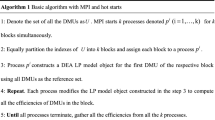Abstract
Job Scheduling in high performance computing (HPC) clusters and grids has traditionally been performed by job entry and management sys tems, such as the Portable Batch System that place their emphasis on job management and only to a lesser extent on job scheduling. In grid infrastruc tures and emerging, virtual machine-based HPC environments, the previous assumption on relative homogeneity of nodes does not hold any more. In con trast, loosely coupled nodes in these settings are more heterogenous than ev er. This places new demands on job scheduling, where a large number of dif ferent nodes create the problem of optimally laying out compute jobs across the network for efficient resource allocation. The proposed approach present ed utilizes non-parametric Data Envelopment Analysis (DEA) to derive a workload-type proximity factor for a given node type. An experimental fac tor determination is performed using 5 physical and one virtual nodes.
Preview
Unable to display preview. Download preview PDF.
Similar content being viewed by others
References
Alexander, M.: Payment Systems Efficiency and Risk, Doctoral Thesis, University of Vienna (1997)
Alexander, M.: Chapter Complex Decision Analysis using Non-Parametric Data Envelopment Analysis. In: Qudrat-Ullah, H., Spector, M., Davidsen, P. (eds.) Complex Decision Making: Theory and Practice, Springer, Heidelberg (forthcoming, 2006)
Ali, A.I., Seiford, L.M.: The mathematical programming approach to efficiency analysis. In: Fried, H.O., Lovell, C.A.K., Schmidt, S.S. (eds.) The measurement of productive efficiency: techniques and applications, Oxford University Press, Oxford (1993)
Andersen, P., Petersen, N.C.: A procedure for ranking efficient units in data envelopment analysis. Management Science 39, 1261–1264 (1993)
Banker, R.D., Charnes, A., Cooper, W.W.: Models for estimating technical and scale efficiencies in data envelopment analysis. Management Science 30, 1078–1092 (1984)
Charnes, A., Cooper, W., Rhodes, E.: Measuring the efficiency of decision making units. European Journal of Operations Research (2), 429–444 (1978)
Hermenier, F., Loriant, N., Hermenier, J.M.: Power Management in Grid Computing with Xen. In: Workshop on XEN in HPC Cluster and Grid Computing Environments as part of ISPA (forthcoming, 2006)
Cluster Resources. Moab Workload Manager, http://www.clusterresources.com
Cluster Resources. TORQUE Resource Manager, http://www.clusterresources.com
JASPA, http://www.dl.ac.uk/TCSC/Staff/Hu_Y_F/SOFTWARE/JASPA/JASPA_1.0.tar.gz
MatrixMarket. Matrix S3DKQ4M2, http://math.nist.gov/Matrix-Market
Portable Batch System, http://www.openpbs.org
Thanassoulis, E., Dyson, R.: Estimating preferred target input-output levels using data envelopment analysis. European Journal of Operations Research (56), 80–97 (1993)
Author information
Authors and Affiliations
Editor information
Editors and Affiliations
Rights and permissions
Copyright information
© 2006 Springer-Verlag Berlin Heidelberg
About this paper
Cite this paper
Alexander, M. (2006). Job Scheduling for Loosely-Coupled Inhomogeneous Nodes Using Data Envelopment Analysis. In: Min, G., Di Martino, B., Yang, L.T., Guo, M., Rünger, G. (eds) Frontiers of High Performance Computing and Networking – ISPA 2006 Workshops. ISPA 2006. Lecture Notes in Computer Science, vol 4331. Springer, Berlin, Heidelberg. https://doi.org/10.1007/11942634_51
Download citation
DOI: https://doi.org/10.1007/11942634_51
Publisher Name: Springer, Berlin, Heidelberg
Print ISBN: 978-3-540-49860-5
Online ISBN: 978-3-540-49862-9
eBook Packages: Computer ScienceComputer Science (R0)




